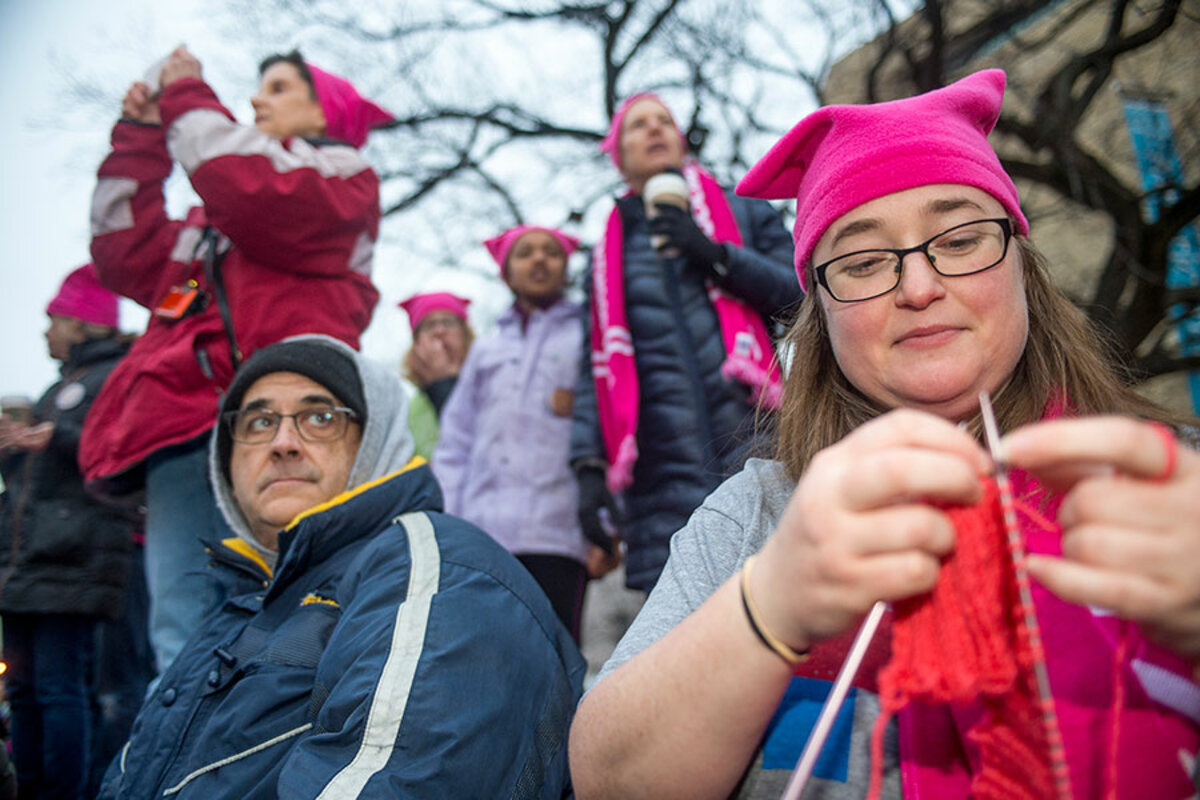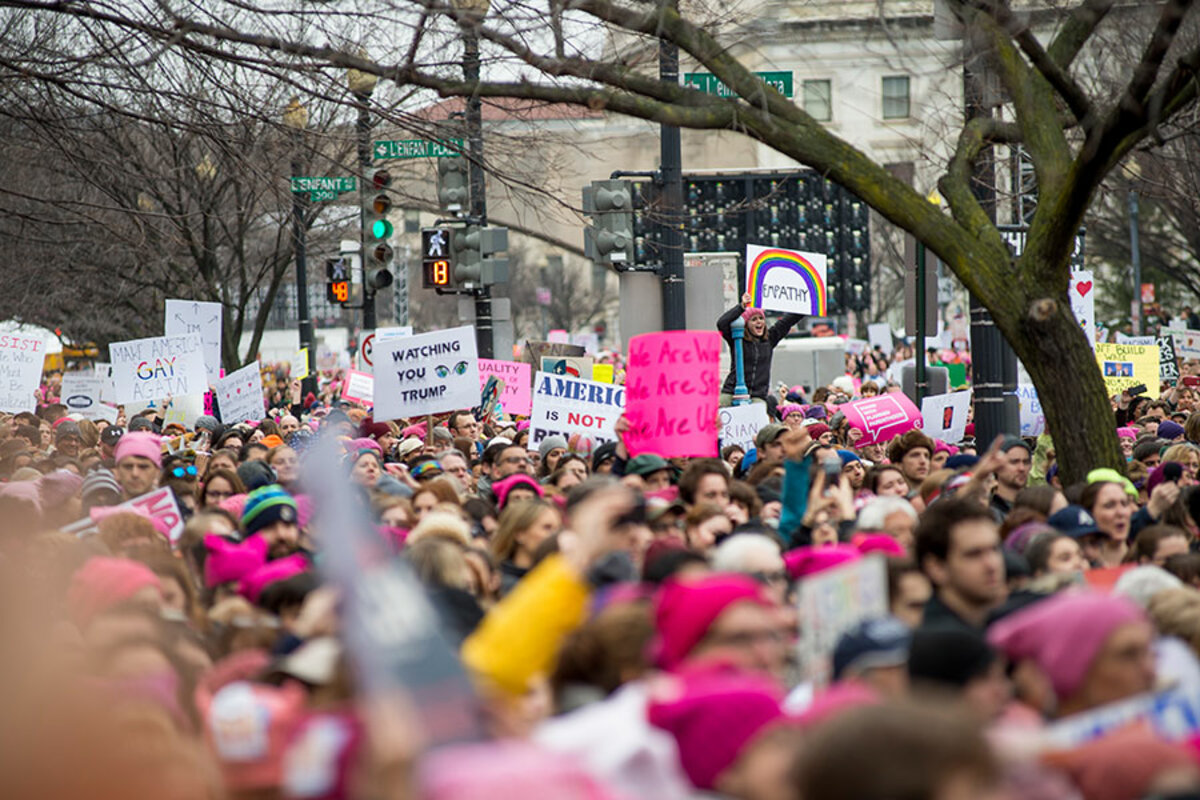Women’s marches: 'This is just the start'
Loading...
| Washington
The sea of pink hats said it all.
Across the National Mall and surrounding streets Saturday in Washington, a mass protest march by women (and men) far surpassed the expected crowd of 200,000. The message for President Trump, one day after his inauguration, was unmistakable: Women’s rights and civil rights will not be forgotten.
All told, millions marched in solidarity at more than 600 events across the United States and around the world, amplifying the sense of alarm many feel about the controversial new president. But the dominant mood, at least in the nation’s capital, was one of enthusiasm and camaraderie, as kindred spirits linked arms and held their protest signs high.
In Washington, high-profile speakers – from feminist icon Gloria Steinem to filmmaker Michael Moore to actress Ashley Judd – rallied the crowd with exhortations to step up their activism. Marching in Washington is great, they said, but more is needed: Volunteer for progressive groups, donate money, call members of Congress, run for office yourselves. Attendees, many wearing the pink knit hats that came to symbolize the protest, echoed that view.
“This is just the start,” says Susan Linderman of Delaware, who took part in civil-rights protests in the 1960s.
Ms. Linderman says she has started contributing to such organizations as the American Civil Liberties Union and Planned Parenthood. But she wants to do more than just write checks. “I’ll call Planned Parenthood on Monday to see if they need volunteers,” she says.
What started as a call to action for women in a Facebook post the day after Mr. Trump’s election last November caught fire into a larger protest movement that encompasses not just reproductive rights and gender equality, but also racial, ethnic, and religious prejudice, health care, climate change, immigration, and gay, lesbian, and transgender rights.
But at its core, it was a women’s march, spurred on by Trump’s rhetoric during the campaign, including disparaging comments about women journalists and politicians – including his election opponent, Hillary Clinton, whom he called a “nasty woman” – and the infamous video in which he bragged about sexually aggressive behavior.
After the election, as planning for the march took off, controversy ensued when organizers rejected the involvement of anti-abortion groups. This sparked debate over the meaning of modern-day feminism. Some women, too, rejected the idea of marching as a feel-good exercise that won’t accomplish anything.
But around the world, the marches themselves amounted to something unique. In New York, as many as 400,000 people took to the street, according to the mayor's office. Los Angeles was “well past” 100,000, according to the police. Boston hit 175,000, the mayor's office said. Elsewhere, independent tallies were not available, but marches in Washington and Chicago were apparently in the hundreds of thousands with no reports of unrest or mass arrests.
“I participated in the Ferguson protests,” said Peyton Galloway, a freshman at Northeastern University who attended the Boston event. “But this is the biggest and most organized I've ever joined. I've knocked on doors before, done stuff like that, but this is a first step in getting involved in such a big and thoughtful way.”
Here in Washington, the march was both cathartic and a potential catalyst for collaboration. Women came from all over the country, and welcomed the chance to meet fellow marchers and brainstorm ways to keep the energy alive. Some brought husbands, boyfriends, children, and grandchildren. Young couples pushed babies in strollers.
Humor was everywhere. “Look who the Russians Put In,” said one sign, an allusion to charges that Russia meddled in the election. “Sad!” said other signs, mocking Trump tweets. Other signs were more serious. “Rest of the world: We are sorry,” said one.
Saturday’s marches may also be a gift to a demoralized Democratic Party, badly in need of energy and new candidates to fill its depleted bench. Some analysts suggest the marches could spark a “tea party of the left.”
Some who gathered here weren’t even Democrats. Connie of Greenwich, Conn., who declined to give her last name, was a registered Republican until last summer, when she changed her registration to independent. She fled the GOP after Trump won its presidential nomination, but she also didn’t much like Mrs. Clinton (and voted for her anyway).
“I cried when Trump won, then the next day I heard about the march, and immediately booked a hotel room,” says Connie, who came down with several busloads of women from Connecticut.
She hopes this march helps people understand something important: voting matters. “People didn’t think their one vote makes a different, but it does,” she says. “They add up.”
Her friend Ingrid, also from Greenwich, has been thinking, too, about the meaning of Saturday’s march. “I told my husband, ‘It can’t stop here. You think of ways, I’ll think of ways to continue this,’” she says. “We need to get involved in local government, get involved with a women’s group. Something. But you have to keep the mission moving forward. This can’t be the end of it.”
Saturday morning began with an air of anticipation. In northwest Washington’s tony Friendship Heights neighborhood, the metro station was overflowing with women in pink hats. But passengers welcomed more onto the car at each stop.
“This is great,” said one man. “People are alive, they are awake.”
By 11 a.m., the National Mall in front of the Smithsonian National Air and Space Museum was chaotic. Thousands walked in different directions, unsure of which way to go. But regardless of the pushing, big crowds, and long lines for Porta-Potties, people took time to say hello to strangers, complimenting them on clever signs.
A group of Latina women carried a sign and shouted in Spanish.
“Viva la chicas Latina!” yelled a white woman nearby. The group of girls laughed at her broken Spanish but gave her a high-five.
Near the Washington Monument, a black man rode a bike with an egg crate filled with mini water bottles roped to the back. He offered a bottle to anyone who walked by. One woman insisted on paying.
“I don’t want any money!” he exclaimed. “Really! Give that money to another organization that needs it.”
At the march, people vowed to be bolder about their beliefs.
Melissa Mack Maruska says she will stop hiding her political beliefs in her small town in northeast Pennsylvania. (“Trump country,” she says.) She also plans to donate to a different organization, such as the National Resource Defense Council, the Children’s Defense Fund, and the Southern Poverty Law Center, every month for the next year.
After the election, “my Trump-supporting friend told me that I need to just move on, put on my big-girl pants,” says Ms. Maruska. “And I said, ‘All right. I’m putting my big-girl pants on and these pants are going marching.’ ”
Wanda McLendon, who lives in the D.C. area, also marched, but her followup plan doesn’t involve money.
“I plan to keep marching on with kindness and love toward others,” said Ms. McLendon, who hopes the positive spirit at the march will carry forward.
“Just like all those signs that people have that say ‘Love Trumps Hate,’ well, you got to put that into practice,” she says. “So when you see someone that is not like you – like when I see someone that is not black doing something mean – I need to trump up some love…. Love is an action word. A lot of times that is a hard thing to do. Hate … is the easy thing to do.”
Brian Yoder of Charlottesville, Va., is thinking about his young son Andre’s future. He says he brought Andre to the march, because he wants him to respect women and not assume that the president’s behavior is acceptable.
“He is going to meet people that share some of the same values that our president does and I want him to understand that some of the things he has done are inappropriate,” says Mr. Yoder. “I’m an educated white male, I don’t have anything to worry about. Trump has my back, but he doesn’t have everybody else’s. So it is on me and everybody else to have everybody else’s backs.”
Arjuan Sharaf, Abrar Bazara, and Noor Kabbani, three young Muslim women from northern Virginia, want to keep disproving stereotypes about Islam.
“We have to go out and show the world what we have in our hands. And what I mean by that is our religion. People have the wrong idea of our religion and how it suppresses women,” says Ms. Bazara.
“And in fact it really doesn’t,” adds Ms. Sharaf. “So we came out to show people that we are all equal, regardless of race, religion, sexuality – everything.”
Staff writer Amelia Newcomb contributed to this report from Boston.








